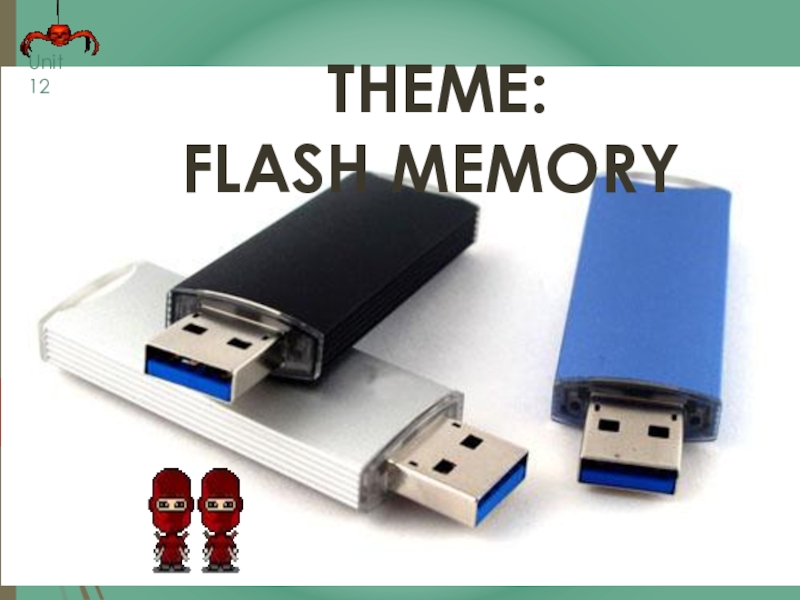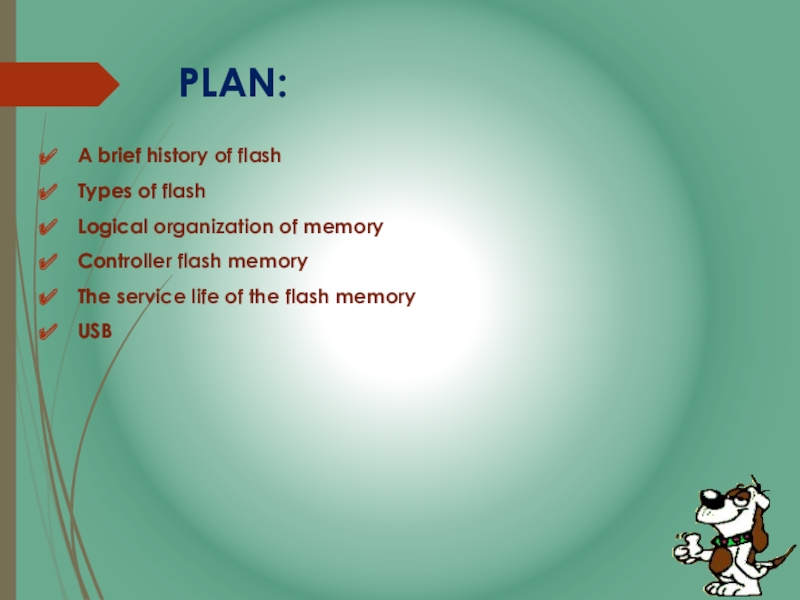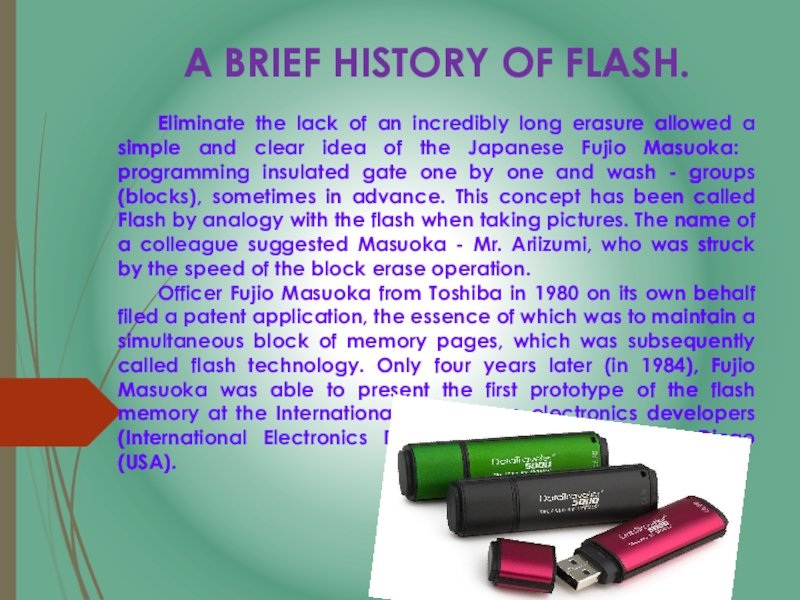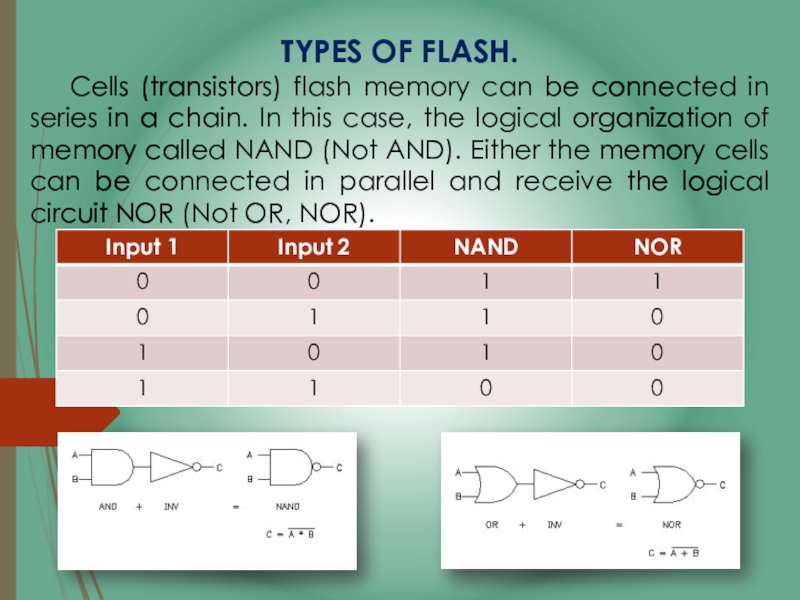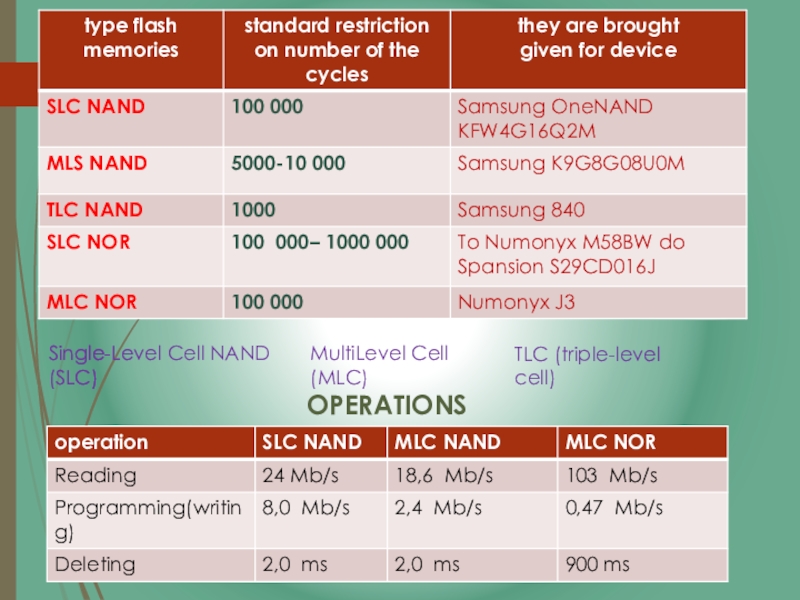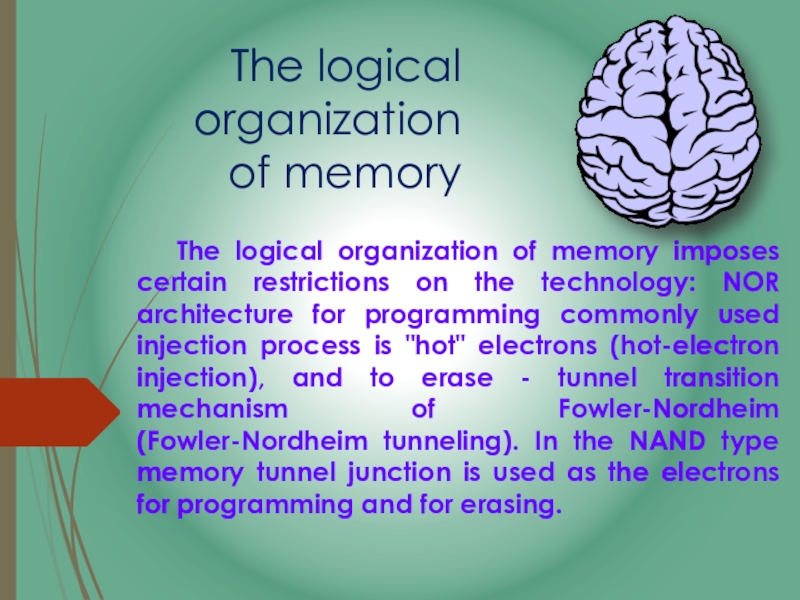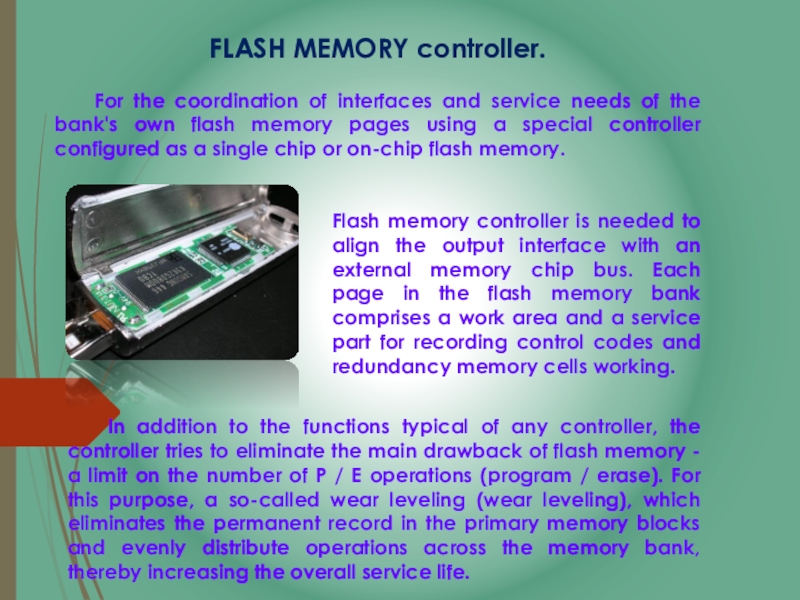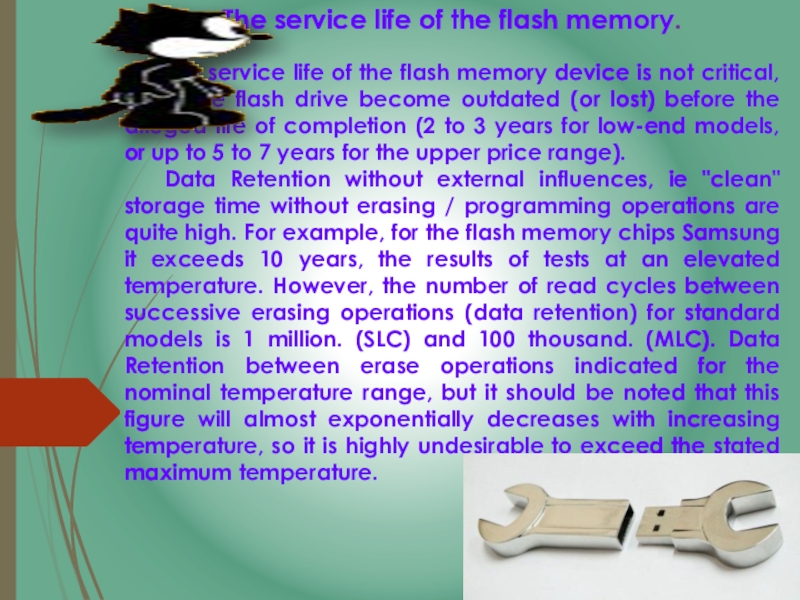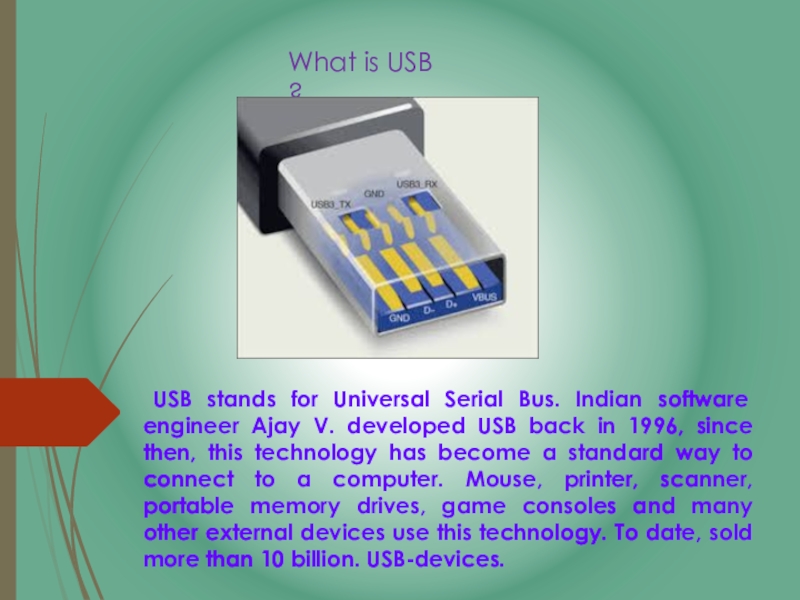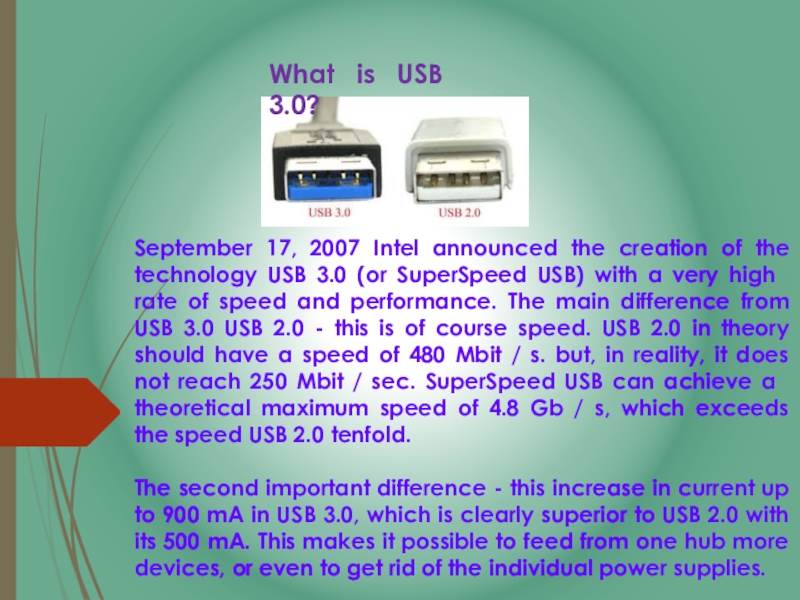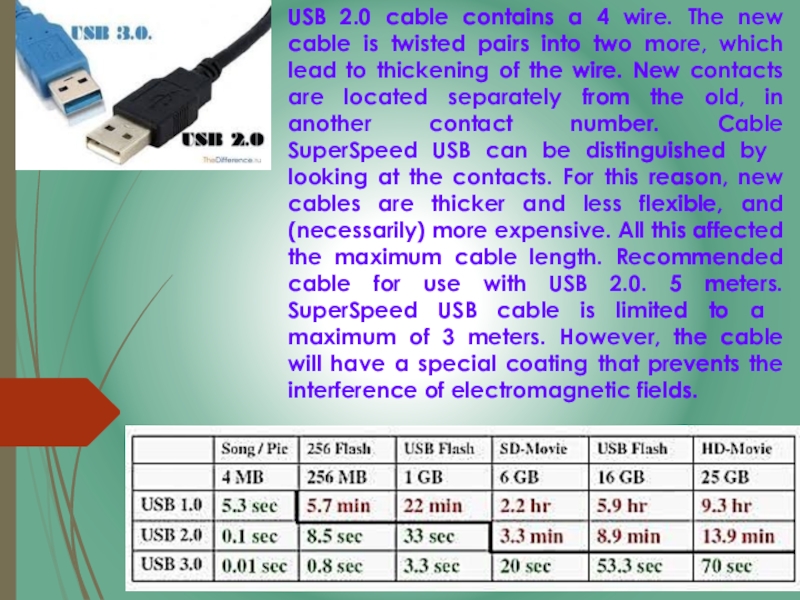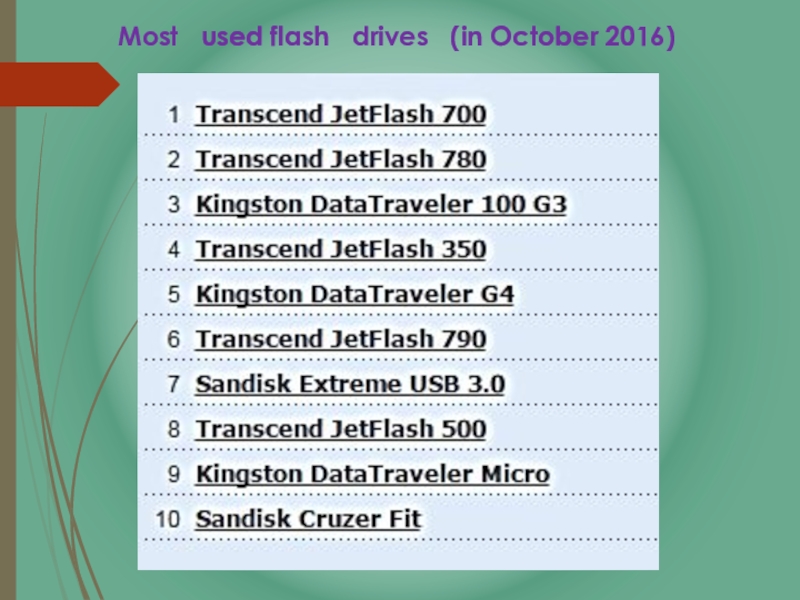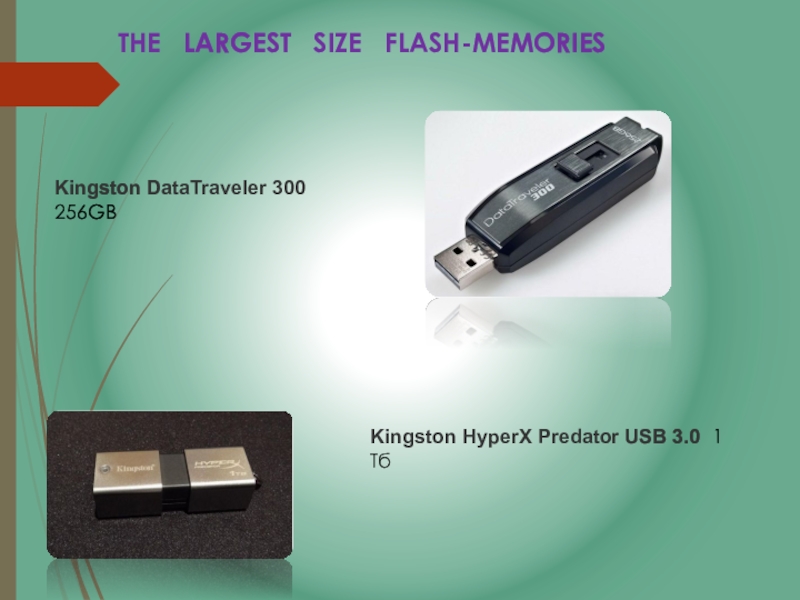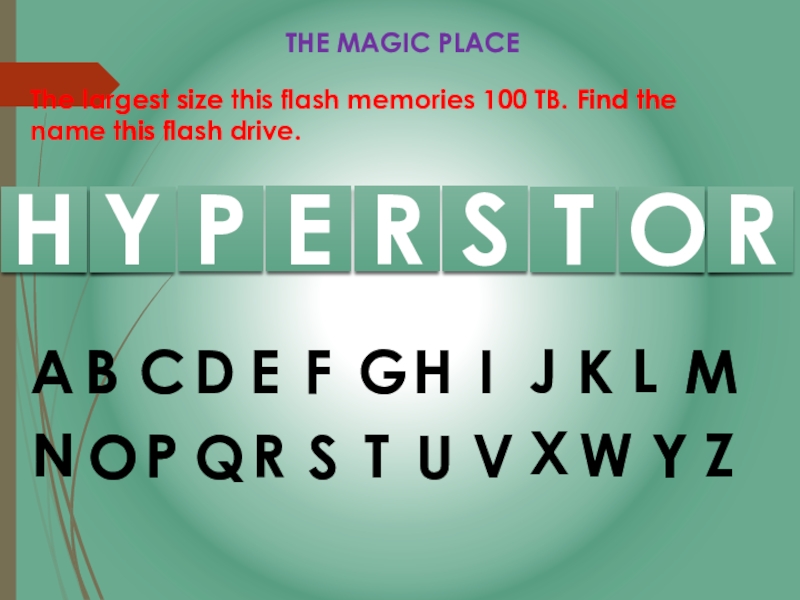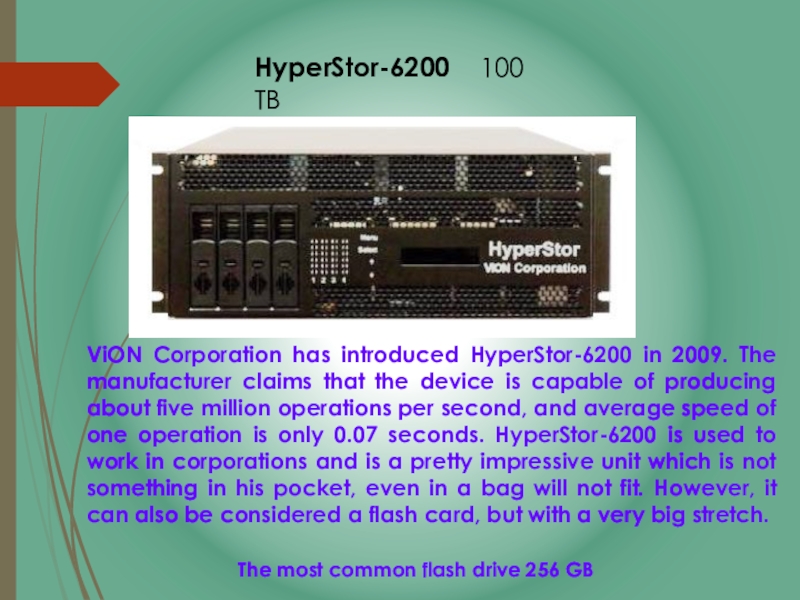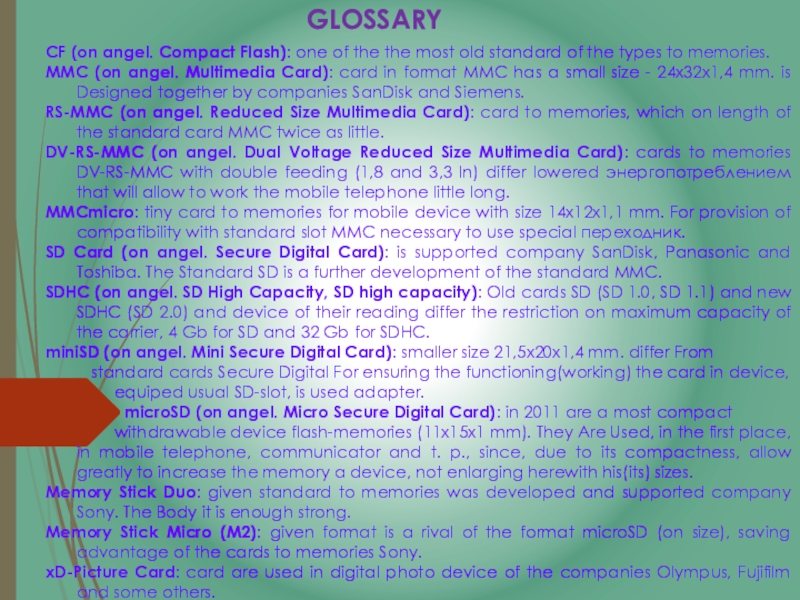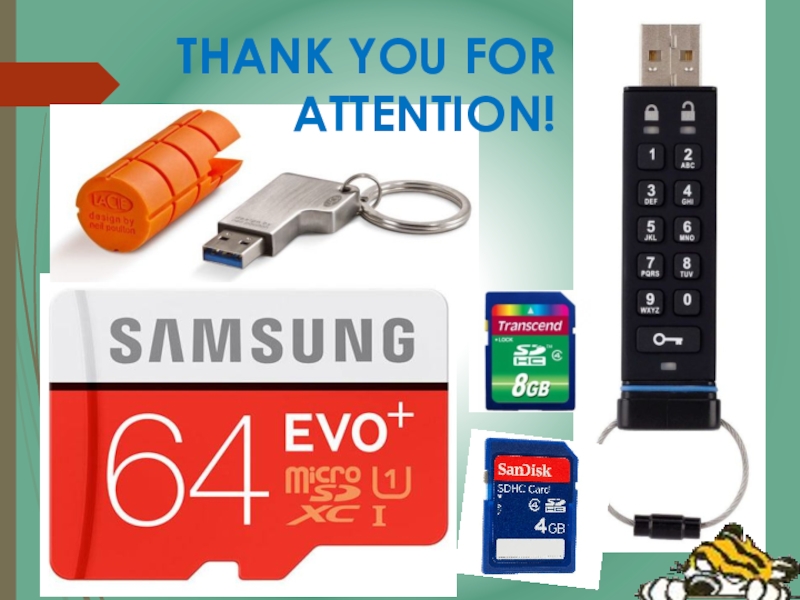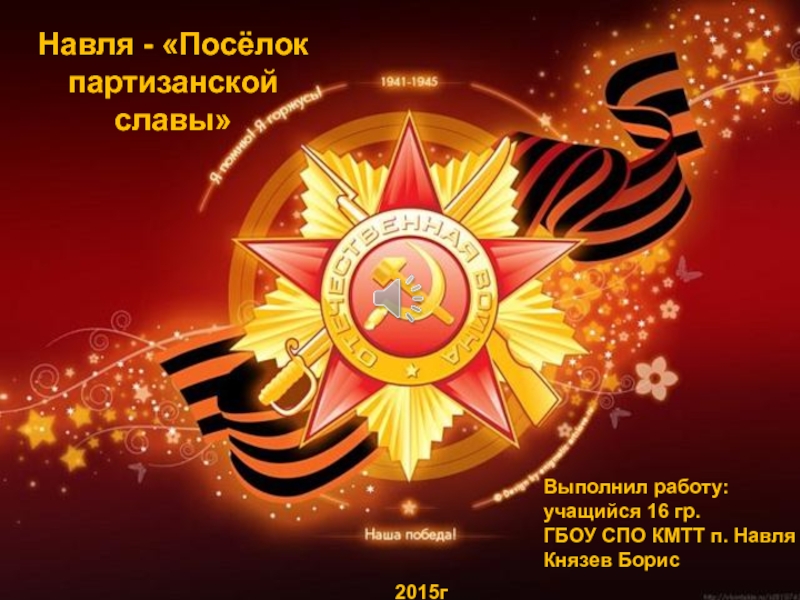- Главная
- Разное
- Образование
- Спорт
- Естествознание
- Природоведение
- Религиоведение
- Французский язык
- Черчение
- Английский язык
- Астрономия
- Алгебра
- Биология
- География
- Геометрия
- Детские презентации
- Информатика
- История
- Литература
- Математика
- Музыка
- МХК
- Немецкий язык
- ОБЖ
- Обществознание
- Окружающий мир
- Педагогика
- Русский язык
- Технология
- Физика
- Философия
- Химия
- Шаблоны, фоны, картинки для презентаций
- Экология
- Экономика
Презентация, доклад на тему Флеш диски на английском языке. 7 класс.
Содержание
- 1. Флеш диски на английском языке. 7 класс.
- 2. PLAN:A brief history of flashTypes of flashLogical
- 3. A BRIEF HISTORY OF FLASH. Eliminate the lack
- 4. TYPES OF FLASH. Cells (transistors) flash memory can
- 5. OPERATIONSSingle-Level Cell NAND (SLC)TLC (triple-level cell)MultiLevel Cell (MLC)
- 6. The logical organization of memory imposes certain
- 7. FLASH MEMORY controller. For the coordination of interfaces
- 8. The service life of the flash memory. The
- 9. 1. USB-connector, 2 controller, 3. PCB-Multilayer PCB
- 10. USB stands for Universal Serial Bus.
- 11. September 17, 2007 Intel announced the creation
- 12. USB 2.0 cable contains a 4 wire.
- 13. Most used flash drives (in October 2016)
- 14. Kingston DataTraveler 300 256GBKingston HyperX Predator
- 15. HYPERSTORABCDEFGHIJKLMNOPQRSTUVXWYZThe largest size this flash memories 100 TB. Find the name this flash drive.THE MAGIC PLACE
- 16. ViON Corporation has introduced HyperStor-6200 in 2009.
- 17. CF (on angel. Compact Flash): one of
- 18. THANK YOU FOR ATTENTION!
Слайд 2PLAN:
A brief history of flash
Types of flash
Logical organization of memory
Controller flash
The service life of the flash memory
USB
Слайд 3A BRIEF HISTORY OF FLASH.
Eliminate the lack of an incredibly long
Officer Fujio Masuoka from Toshiba in 1980 on its own behalf filed a patent application, the essence of which was to maintain a simultaneous block of memory pages, which was subsequently called flash technology. Only four years later (in 1984), Fujio Masuoka was able to present the first prototype of the flash memory at the International Conference electronics developers (International Electronics Developers Meeting) in San Diego (USA).
Слайд 4TYPES OF FLASH.
Cells (transistors) flash memory can be connected in series
Слайд 6 The logical organization of memory imposes certain restrictions on the technology:
The logical
organization
of memory
Слайд 7FLASH MEMORY controller.
For the coordination of interfaces and service needs of
Flash memory controller is needed to align the output interface with an external memory chip bus. Each page in the flash memory bank comprises a work area and a service part for recording control codes and redundancy memory cells working.
In addition to the functions typical of any controller, the controller tries to eliminate the main drawback of flash memory - a limit on the number of P / E operations (program / erase). For this purpose, a so-called wear leveling (wear leveling), which eliminates the permanent record in the primary memory blocks and evenly distribute operations across the memory bank, thereby increasing the overall service life.
Слайд 8The service life of the flash memory.
The service life of the
Data Retention without external influences, ie "clean" storage time without erasing / programming operations are quite high. For example, for the flash memory chips Samsung it exceeds 10 years, the results of tests at an elevated temperature. However, the number of read cycles between successive erasing operations (data retention) for standard models is 1 million. (SLC) and 100 thousand. (MLC). Data Retention between erase operations indicated for the nominal temperature range, but it should be noted that this figure will almost exponentially decreases with increasing temperature, so it is highly undesirable to exceed the stated maximum temperature.
Слайд 91. USB-connector, 2 controller, 3. PCB-Multilayer PCB 4. NAND memory module
USB
KEY ELEMENTS USB-FLASH DRIVE:
Слайд 10 USB stands for Universal Serial Bus. Indian software engineer Ajay
What is USB ?
Слайд 11September 17, 2007 Intel announced the creation of the technology USB
The second important difference - this increase in current up to 900 mA in USB 3.0, which is clearly superior to USB 2.0 with its 500 mA. This makes it possible to feed from one hub more devices, or even to get rid of the individual power supplies.
What is USB 3.0?
Слайд 12USB 2.0 cable contains a 4 wire. The new cable is
Слайд 14Kingston DataTraveler 300 256GB
Kingston HyperX Predator USB 3.0 1 Тб
THE
Слайд 15H
Y
P
E
R
S
T
O
R
A
B
C
D
E
F
G
H
I
J
K
L
M
N
O
P
Q
R
S
T
U
V
X
W
Y
Z
The largest size this flash memories 100 TB. Find the name
THE MAGIC PLACE
Слайд 16ViON Corporation has introduced HyperStor-6200 in 2009. The manufacturer claims that
HyperStor-6200 100 TB
The most common flash drive 256 GB
Слайд 17CF (on angel. Compact Flash): one of the the most old
MMC (on angel. Multimedia Card): card in format MMC has a small size - 24х32х1,4 mm. is Designed together by companies SanDisk and Siemens.
RS-MMC (on angel. Reduced Size Multimedia Card): card to memories, which on length of the standard card MMC twice as little.
DV-RS-MMC (on angel. Dual Voltage Reduced Size Multimedia Card): cards to memories DV-RS-MMC with double feeding (1,8 and 3,3 In) differ lowered энергопотреблением that will allow to work the mobile telephone little long.
MMCmicro: tiny card to memories for mobile device with size 14х12х1,1 mm. For provision of compatibility with standard slot MMC necessary to use special переходник.
SD Card (on angel. Secure Digital Card): is supported company SanDisk, Panasonic and Toshiba. The Standard SD is a further development of the standard MMC.
SDHC (on angel. SD High Capacity, SD high capacity): Old cards SD (SD 1.0, SD 1.1) and new SDHC (SD 2.0) and device of their reading differ the restriction on maximum capacity of the carrier, 4 Gb for SD and 32 Gb for SDHC.
miniSD (on angel. Mini Secure Digital Card): smaller size 21,5х20х1,4 mm. differ From
standard cards Secure Digital For ensuring the functioning(working) the card in device,
equiped usual SD-slot, is used adapter.
microSD (on angel. Micro Secure Digital Card): in 2011 are a most compact
withdrawable device flash-memories (11х15х1 mm). They Are Used, in the first place, in mobile telephone, communicator and t. p., since, due to its compactness, allow greatly to increase the memory a device, not enlarging herewith his(its) sizes.
Memory Stick Duo: given standard to memories was developed and supported company Sony. The Body it is enough strong.
Memory Stick Micro (M2): given format is a rival of the format microSD (on size), saving advantage of the cards to memories Sony.
xD-Picture Card: card are used in digital photo device of the companies Olympus, Fujifilm and some others.
GLOSSARY
